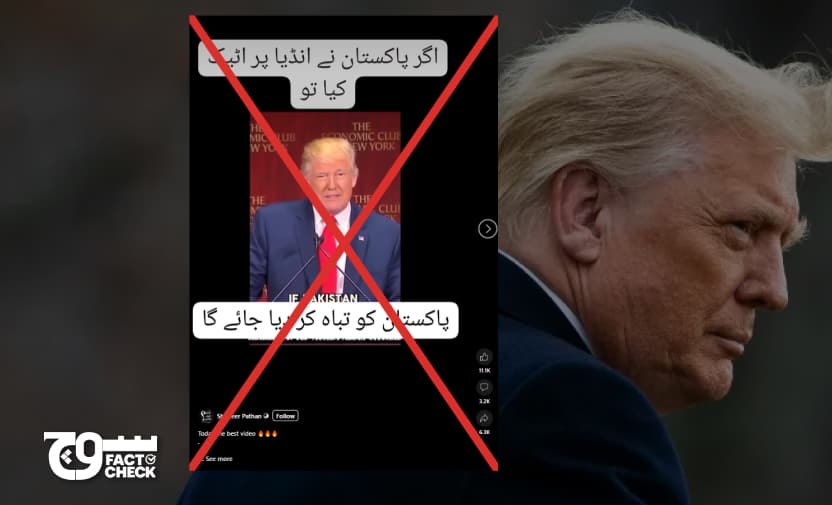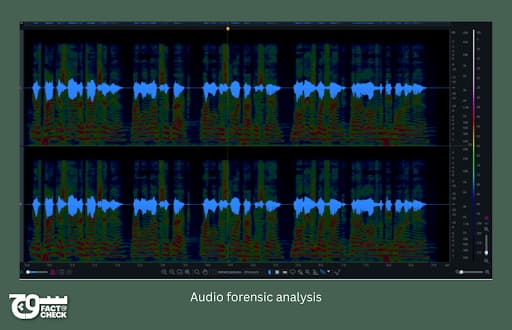
Claim: A video shows US President Donald Trump threatening to destroy Pakistan if it attacked India.
Fact: The viral video is digitally manipulated. Trump has consistently taken a neutral stance on tensions between India and Pakistan. Forensic audio analysis and deepfake detection tools confirm that the clip is fabricated.
A video (archive) circulating widely on social media shows President Donald Trump saying, “If Pakistan attacks India, I will not sit back. I will destroy Pakistan. Modi is my friend, and I love the people of India.”
The video also contains an Urdu caption that reads:
“اگر پاکستان نے انڈیا پر اٹیک کیا تو پاکستان کو تباہ کر دیا جائے گا”
[Translation: If Pakistan attacks India, Pakistan will be destroyed.]
The video was shared as early as 5 May, but gained renewed traction after Indian airstrikes in Pakistan and Pakistan’s response.
Fact or Fiction?
Soch Fact Check suspected the authenticity of the viral video, particularly in light of the US President’s initial neutral response to the attack in Pahalgam in Indian-administered Kashmir. When asked about the situation, he remarked that tensions between India and Pakistan had persisted for “1,500 years” and added, “They’ll get it figured out, one way or the other, I’m sure of that. There’s been great tension between Pakistan and India, but there always has been.” In response to a question about whether he would speak to Prime Ministers Shehbaz Sharif or Narendra Modi, Trump stated, “I am very close to India and I’m very close to Pakistan.”
His remarks reflected a neutral stance and he avoided taking sides.
Similarly, following Indian airstrikes in Pakistan in the early hours of 7 May and Pakistan’s subsequent response, Trump addressed the developments later that evening in the US, saying: “It’s a shame. We just heard about it as we were walking through the doors of the Oval. Commenting on the broader conflict, he added, “They’ve been fighting for a long time… I just hope it ends very quickly.”
The US President’s consistent neutrality further confirms that the viral video is fake and does not reflect his actual position on the escalation.
While we could not trace the original source of the manipulated video, Shaur Azher, an audio engineer at our sister company Soch Videos, conducted a sound analysis of Trump’s voice in the clip and confirmed that it is digitally manipulated. Through forensic audio analysis, he identified several inconsistencies in Trump’s voice as well. Once the spoken dialogue was isolated and hall reverb removed, unnatural or synthetic frequencies, which are indicators of AI-generated or deepfake audio, became more apparent.

Additionally, the audio exhibited excessive compression, a technique used to artificially balance volume levels, which is not typical of genuine, live recordings.
He further pointed to evidence showing that a layer of artificial reverb was added in post-production. The reverb mimics the acoustics of a real-world setting, a known method used to disguise audio manipulation.
Based on spectral and signal processing data, the audio has been fabricated, Azher concluded.
Soch Fact Check also analysed the video using Deepware Scanner, a tool designed to detect suspicious content and identify potential synthetic manipulation. According to the Seferbekov model, the video contained 68% deepfake elements. Meanwhile, the Ensemble analysis, which combines results from multiple detection tools, rated the video as 61% suspicious. These findings suggest significant manipulation, particularly in Trump’s facial features and speech.
Based on the US President’s current neutral stance regarding the military escalation between India and Pakistan, as well as the forensic audio analysis, and results from Deepware Scanner, Soch Fact Check concludes that the viral video is a deepfake. It does not reflect any real statements made by president Trump.
India attacks sites in Pakistan
Indian airstrikes in Pakistan
In the early hours of 7 May, the Indian military launched Operation Sindoor and targeted various locations inside Pakistan and Pakistan-administered Kashmir, killing at least 31 people and wounding 57 others, according to Pakistani authorities. At least three children were killed by the strikes.
The attacks marked the most expansive military action between the two nations since 1971.
Pakistan military’s media-wing Inter-Services Public Relations (ISPR) has said civilian areas in at least six locations — including Ahmedpur East, Muridke, Sialkot, Shakargarh, Kotli, and Muzaffarabad — were targeted.
India, however, alleged it targeted nine “terrorist camps”, a claim which has not yet been independently verified. Pakistan, on the other hand, has asserted that these sites are densely populated civilian areas. Emerging footage and on-ground reporting shows that civilians, including women and children, were injured in the attack, which lends credibility to Pakistan’s assertions that civilian areas were harmed, contrary to claims made by Indian officials. Soch Fact Check also independently confirmed deaths of several civilians in Bahawalpur, including two children.
Notably, military strikes in Pakistani Punjab are across a recognised international border and constitute a major escalation relative to the surgical strikes carried out along the Line of Control (LoC), the ceasefire line that divides Pakistan-administered Kashmir from Indian-administered Kashmir.
Pakistan’s Prime Minister Shehbaz Sharif condemned the airstrikes, saying his country “has every right to give a robust response to this act of war imposed by India”.
The Pahalgam Attack
India claims its strikes were a response to the terror attack in Pahalgam in Indian-administered Kashmir on 22 April, which killed 26 people, mostly tourists.
Indian officials linked the attack to Pakistan, but Islamabad has denied the claim. The Resistance Front – a group that Indian officials maintain is a proxy front for the Pakistan-based militant group Lashkar-e-Taiba (LeT) – initially claimed responsibility for that attack but later retracted its statement.
Pakistan demanded a neutral investigation, asserting that India has not provided any evidence to support its allegations of Pakistan’s involvement in the attack.
The Indus Waters Treaty
Soon after the attack on tourists in Pahalgam, New Delhi announced the suspension of the Indus Waters Treaty, which has been in place since 1960 and has survived two wars between the neighbouring nuclear countries. Pakistan stated that attempts to stop or divert Pakistan’s water would be considered an “act of war and responded with full force across the complete spectrum of national power”.
On Tuesday, after a UNSC meeting to discuss the matter, Indian Prime Minister Narendra Modi said, “Now, India’s water will flow for India’s benefit, it will be conserved for India’s benefit, and it will be used for India’s progress”.
Pakistan and International response to Indian attack
Hours after Indian strikes hit multiple Pakistani locations, the Pakistani military announced that they had brought down five Indian jets. Defense Minister Khawaja Asif informed Bloomberg TV that the country shot down five Indian jets and multiple unmanned aerial vehicles, along with destroying checkposts at the Line of Control (LoC). Indian officials apparently acknowledged that three of their “fighter jets” had “crashed” within their territory, Reuters (archive) and New York Times (archive)reported on 7 May 2025.
According to a press release issued by the Press Information Department (PID), after Pakistan’s National Security Committee (NSC) convened on the morning of 7 May, India also targeted the Neelum-Jhelum Hydropower Project.
“The international media personnel had already visited these ‘imaginary terrorist camps’ on 6 May 2025 and more visits were planned for 7 May 2025,” the press release said.
After the Pahalgam incident, “Pakistan made a sincere offer for a credible, transparent and neutral investigation, which unfortunately was not accepted” by India, it added.
The NSC also authorised the armed forces “to undertake corresponding actions” following the 7 May strikes by India.
The UN Secretary General António Guterres urged both India and Pakistan to exercise military restraint, adding that “the world cannot afford a military confrontation between India and Pakistan.”
The same day, Indian Prime Minister Narendra Modi chaired a high-level meeting with senior federal ministers but has so far not made any public comments since the airstrikes, according to CNN.
Following India’s attack on Pakistan, multiple countries issued statements, with Russia saying it was “deeply concerned” about the escalation, China noting that it “regrets” New Delhi’s military action and urging “restraint”, the US stating that it hoped the conflict “ends very quickly”, and the UK promising that it will “stand ready” to assist in deescalating tensions between the two countries.
A surge of unverified claims and disinformation has circulated on social media since the Pahalgam terror attack, and it has spiked sharply after India launched missile strikes into Pakistani territory early Wednesday morning.
Virality
The video was shared here, here, here, and here on Facebook. Archived here, here, here, and here.
Conclusion: The viral video claiming to show US President Donald Trump threatening to destroy Pakistan if it attacked India is digitally manipulated and inauthentic, likely AI-generated. Trump has consistently taken a neutral stance on tensions between India and Pakistan. Most importantly, our forensic audio analysis and results from deepfake detection tools confirm that the clip is fake.
To appeal against our fact-check, please send an email to appeals@sochfactcheck.com
